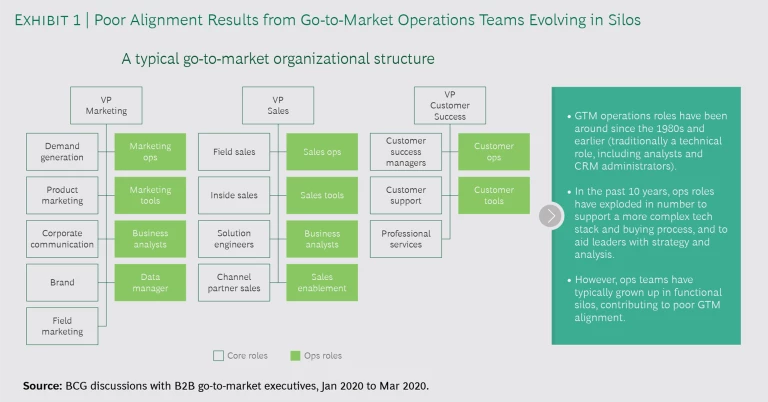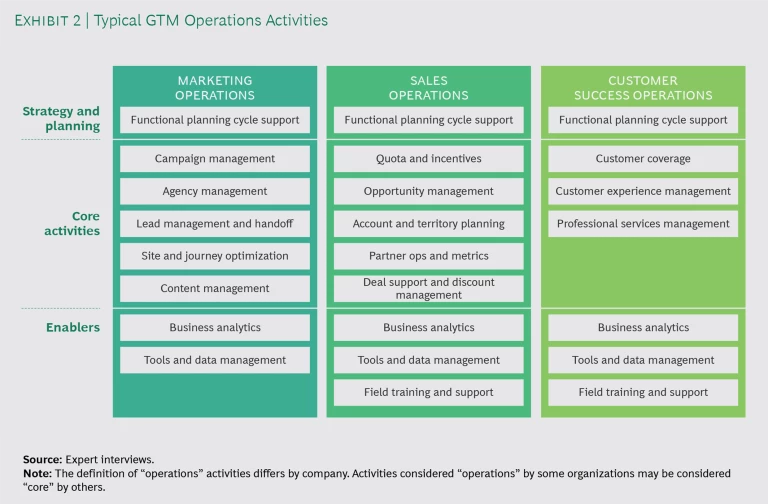New technologies and increasingly sophisticated buyer behaviors are changing how customer acquisition and retention are managed at B2B technology companies. Chief revenue officers, as well as other leaders of sales, marketing, and customer success functions, must evolve their operating models if they hope to stay ahead. These changes will take on heightened importance as tech players adopt more virtualized sales motions in response to the coronavirus crisis. Such changes also will continue to provide companies with sustainable advantage, once demand for their products and services fully rebounds.
RevOps, the concept of centralizing operations teams from marketing, sales, and customer success, has emerged as a high-impact way to accelerate revenue growth and go-to-market (GTM) operations efficiency through tighter alignment of these functions. Top B2B technology companies, led by software as a service (SaaS) providers, are reporting substantial benefits, including:
- 100% to 200% increases in digital marketing ROI
- 10% to 20% increases in sales productivity
- 10% increases in lead acceptance
- 15% to 20% increases in internal customer satisfaction
- 30% reductions in GTM expenses
The Challenge for Sales and Marketing Today
Many GTM executives today wrestle with achieving efficient, predictable, and sustained growth. Increased customer sophistication has made sales and marketing more complicated, as have a proliferation of tools, data, and metrics, faster product and services innovation, and lower competitive barriers. For GTM executives to make informed decisions, the operations functions that support sales, marketing, and customer success must work together to produce data and insights that meet consistent standards and metrics as they track customers moving along the purchasing journey .
Few GTM functions perform that way today. While sales and marketing teams often are equipped with better tools than ever before—from more-sophisticated CRMs to specialized marketing automation platforms and customer success software—their experience with the expanding tech stack is often marred by spotty adoption and poor integration. Poor integration is often exacerbated by the fact that GTM teams are run in silos with misaligned incentives. (See Exhibit 1.) These teams struggle with many issues, including data consistency and reliability, tech stack integration, competing sources of information, duplication of reporting and forecasting, low cross-functional collaboration and trust, and broken hand-over processes.
Effective integration is tough, but those who achieve even partial success will reap big returns by helping their GTM teams go after the right customer segments, in the right way, at the right time.
The Case for RevOps
To achieve better GTM alignment, more companies are centralizing some or all of their GTM operations into a single RevOps function. Centralization has multiple benefits.
First, it makes it easier to streamline end-to-end purchasing funnel activities, including standardizing reporting, metrics, and tools. Improved performance from RevOps-driven alignment shows in key metrics such as customer lifetime value versus acquisition cost (LTV/CAC) ratios, customer satisfaction scores, as well as marketing and sales pipeline velocity. As already noted, we have seen clients who have made end-to-end funnel integration a priority increase their marketing ROI by up to 200% and boost sales productivity by as much as 20%.
To achieve better GTM alignment, more companies are centralizing some or all of their GTM operations into a single RevOps function.
Second, RevOps improves the efficiency of GTM investments in people and tools. Centralization streamlines priority setting and decision making for key activities such as training, day-to day-execution, as well as process and tool design and implementation.
Third, RevOps can accelerate the execution of GTM growth levers such as price realization and cross-selling by arming sales and customer success teams with the right enablers in the form of tools, metrics, processes, and operational support.
Recently, we observed a real-world example of such benefits at a fast growing SaaS company that used RevOps to scale its GTM as it doubled revenues, from $500 million to $1 billion. By streamlining back-end GTM processes, they decreased unproductive time for sales reps, improved the integration of tools and prioritization of investments, reduced costs by removing duplicate roles, and reduced attrition through improved career prospects for operations personnel.
Barriers to RevOps
Not all companies, however, see centralizing GTM operations teams as an immediate opportunity. We have heard executives express concern around three main issues:
- The organizational and cultural change required is too large and too scary to tackle, and the transformation costs would outweigh the potential benefits. As one manager put it, “Things are working OK today. I don’t think the additional benefits are worth the cost of such a big organizational change.”
- Centralized GTM operations staff could lose close working relationships with frontline staff in marketing, sales, and customer success. For instance, one executive said: “My experience is that centralized teams are not very effective at execution, because it becomes easy to only focus on the strategy and not the execution.”
- Many organizations believe they do not have a good place for RevOps to report. A common sentiment expressed by those with a decentralized operating model is, “If we had centralized RevOps, I’d want it reporting to the chief revenue officer. So unless there’s a CRO, I just can’t see it working: either sales or marketing would get neglected.”
Through our work we have seen that all of these commonly expressed concerns and barriers can be overcome with the right approach. And while implementing RevOps is a significant undertaking for any sizable organization, we believe the benefits outweigh the investments for many B2B businesses. Most importantly, at companies where GTM is already misaligned and clear action to create alignment is not taken, our experience shows that matters often tend to get worse over time as individual teams continue to invest in diverging strategies and workarounds.
How to Succeed with RevOps
To understand where RevOps can have a positive impact and to see how substantial that impact may be, leadership should start by diagnosing the current state of their GTM processes and the operations behind them. This diagnostic effort should include a review of current strategy and planning processes; cross-functional execution and incentives; metrics and dashboards; and tools, data, and people. BCG has developed a diagnostic survey that can help B2B executives determine whether improving GTM alignment should be a priority.
Leadership should start by diagnosing the current state of their GTM processes and the operations behind them.
Once a company determines RevOps is the right move, the next question is how to set up the function, including which groups, processes, and tools to centralize. (See Exhibit 2.) Typically, more than half of GTM operations activities and the people performing them are strong candidates for centralization.
The insights from the diagnostic will enable management to establish a strong set of guidelines for where to focus and how to sequence the transformation effort. For example, one company might find that trust among GTM teams is high but current alignment is low. In this case, it should consider centralizing reporting lines first and then adjust the ways in which teams work together. At another organization where trust is low, it might be better to start with a smaller degree of change, such as partial centralization or virtual alignment. Alternatively, a leadership shakeup can be a way to reset the trust and culture as a first step on the journey.
For large organizations, a hybrid RevOps model can be a good solution. For instance, several successful B2B tech companies use a hub-and-spoke model to maintain the connection with, and functional support for, field operations. A centralized RevOps organization sets standards, manages common processes and tools, coordinates across regions and functions, and prioritizes and executes major projects. Regional operations teams leverage the central RevOps resources but customize processes for regional theaters and provide day-to-day support for regional leaders. This model balances speed of service for the regions with the coordination benefits of a centralized RevOps team.
Several successful B2B tech companies use a hub-and-spoke model to maintain the connection with, and functional support for, field operations.
Whatever the starting point and path the organization chooses, leaders should keep in mind six important success factors for a RevOps transformation:
- Systematically lay out the starting point by conducting the type of diagnostic we’ve just described. Review it with all key stakeholders to ascertain if everyone has the same understanding of the current state of affairs.
- Weigh the benefits and costs of a change carefully. Use the diagnostic to understand key areas of opportunity and devise a plan for your transformation. Centralized RevOps is right for many companies, but not a one-size-fits-all solution for everyone.
- Identify a leader with cross-functional experience who can influence change at a large scale. The right leader should be motivated to optimize benefits for the full business, not just one GTM function. This person may not exist today within the GTM organization, in which case companies need to consider bringing in someone from another function or from the outside.
- Let go of leaders and team members not willing to embrace the new cross-functional mindset. Very likely, some people will prefer to “look after their own.” This mindset will act as a poison, reducing the positive impact of the transformation and perhaps derailing it altogether.
- Plan to improve processes and tools, not just change the organizational structure. Org restructuring alone is not a silver bullet and constitutes only a small part of the solution. Processes and tools are where results are produced and benefits are realized.
- Consider resetting your entire GTM tech stack. Do not make this decision lightly, but remember that any prior investments made are sunk costs and not reasons to hold onto what you have. Restarting from scratch comes with its own meaningful costs and risks but must be compared with the often prohibitive complexity and cost of unwinding technical debt accumulated by previous siloed decisions.
The pace of
technology-driven change
in B2B GTM will only increase, as will the complexity of maximizing GTM effectiveness and efficiency. Those who organize their GTM operations to provide the most robust, seamless, aligned, and efficient operational support will have an increasingly important advantage over those who do not.













